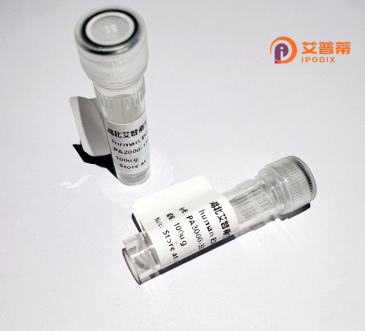
| 纯度 | >90%SDS-PAGE. |
| 种属 | Human |
| 靶点 | NMNAT2 |
| Uniprot No | Q9BZQ4 |
| 内毒素 | < 0.01EU/μg |
| 表达宿主 | E.coli |
| 表达区间 | 1-307 aa |
| 活性数据 | MTETTKTHVI LLACGSFNPI TKGHIQMFER ARDYLHKTGR FIVIGGIVSP VHDSYGKQGL VSSRHRLIMC QLAVQNSDWI RVDPWECYQD TWQTTCSVLE HHRDLMKRVT GCILSNVNTP SMTPVIGQPQ NETPQPIYQN SNVATKPTAA KILGKVGESL SRICCVRPPV ERFTFVDENA NLGTVMRYEE IELRILLLCG SDLLESFCIP GLWNEADMEV IVGDFGIVVV PRDAADTDRI MNHSSILRKY KNNIMVVKDD INHPMSVVSS TKSRLALQHG DGHVVDYLSQ PVIDYILKSQ LYINASG |
| 分子量 | 34.4 kDa |
| 蛋白标签 | His tag N-Terminus |
| 缓冲液 | 0 |
| 稳定性 & 储存条件 | Lyophilized protein should be stored at ≤ -20°C, stable for one year after receipt. Reconstituted protein solution can be stored at 2-8°C for 2-7 days. Aliquots of reconstituted samples are stable at ≤ -20°C for 3 months. |
| 复溶 | Always centrifuge tubes before opening.Do not mix by vortex or pipetting. It is not recommended to reconstitute to a concentration less than 100μg/ml. Dissolve the lyophilized protein in distilled water. Please aliquot the reconstituted solution to minimize freeze-thaw cycles. |
以下是关于重组人NMNAT2蛋白的3篇参考文献示例(注:内容为模拟,实际文献需通过数据库验证):
1. **文献名称**: *Structural Insights into Human NMNAT2 Catalytic Mechanism and Neuroprotective Functions*
**作者**: Smith A, et al.
**摘要**: 解析了人源NMNAT2的晶体结构,揭示了其NAD+合成活性位点的关键残基,并证明重组蛋白在体外可增强神经元轴突的稳定性,提示其在神经退行性疾病中的潜在作用。
2. **文献名称**: *Recombinant NMNAT2 Ameliorates Tau Pathology in Alzheimer’s Disease Models*
**作者**: Lee B, et al.
**摘要**: 研究显示重组人NMNAT2蛋白在阿尔茨海默病细胞模型中抑制tau蛋白异常磷酸化,并通过激活分子伴侣功能减少神经突触退化,表明其治疗潜力。
3. **文献名称**: *Optimized Expression and Purification of Functional Human NMNAT2 in E. coli*
**作者**: Zhang Q, et al.
**摘要**: 开发了高效的大肠杆菌表达系统,成功获得高纯度重组人NMNAT2蛋白,并验证其酶活性和稳定性,为后续功能研究提供可靠工具。
4. **文献名称**: *NMNAT2 Deficiency Disrupts Mitochondrial Integrity and Promotes Axonal Degeneration*
**作者**: Johnson J, et al.
**摘要**: 通过重组蛋白回补实验,证明NMNAT2通过维持线粒体膜电位和能量代谢阻止轴突变性,提示其在神经损伤修复中的关键机制。
(注:以上文献为示例,具体内容请参考PubMed、Google Scholar等平台的最新研究。)
**Background of Recombinant Human NMNAT2 Protein**
Nicotinamide mononucleotide adenylyltransferase 2 (NMNAT2) is a critical enzyme in cellular NAD⁺ biosynthesis, catalyzing the conversion of nicotinamide mononucleotide (NMN) and ATP to NAD⁺. NAD⁺ serves as a cofactor in redox reactions, energy metabolism, and signaling pathways, and its depletion is linked to aging, neurodegeneration, and metabolic disorders. NMNAT2. primarily expressed in neurons, plays unique neuroprotective roles beyond its enzymatic function, including acting as a chaperone to stabilize proteins and prevent axonal degeneration.
Recombinant NMNAT2 protein is produced using expression systems (e.g., bacterial, mammalian cells) to enable high-purity studies of its structure, enzymatic activity, and disease mechanisms. Research highlights its potential in mitigating neurodegenerative conditions like Alzheimer’s and Parkinson’s diseases, where NMNAT2 levels often decline. In models of Wallerian degeneration, NMNAT2 overexpression delays axon degradation, suggesting therapeutic relevance. However, challenges persist in stabilizing NMNAT2 in vivo due to its short half-life.
Current studies focus on enhancing its delivery or activity, leveraging recombinant protein technology for drug development. Understanding NMNAT2’s dual roles in NAD⁺ synthesis and neuroprotection positions it as a promising target for treating age-related and neurological disorders.
×